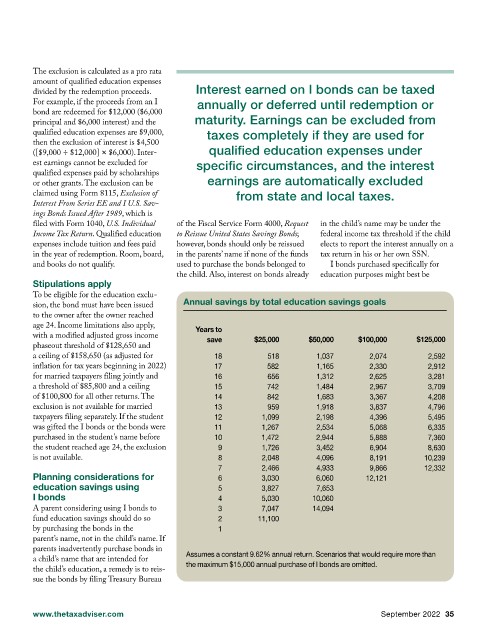Page 475 - TaxAdviser_2022
P. 475
The exclusion is calculated as a pro rata
amount of qualified education expenses
divided by the redemption proceeds. Interest earned on I bonds can be taxed
For example, if the proceeds from an I annually or deferred until redemption or
bond are redeemed for $12,000 ($6,000
principal and $6,000 interest) and the maturity. Earnings can be excluded from
qualified education expenses are $9,000, taxes completely if they are used for
then the exclusion of interest is $4,500
([$9,000 ÷ $12,000] × $6,000). Inter- qualified education expenses under
est earnings cannot be excluded for specific circumstances, and the interest
qualified expenses paid by scholarships
or other grants. The exclusion can be earnings are automatically excluded
claimed using Form 8115, Exclusion of from state and local taxes.
Interest From Series EE and I U.S. Sav-
ings Bonds Issued After 1989, which is
filed with Form 1040, U.S. Individual of the Fiscal Service Form 4000, Request in the child’s name may be under the
Income Tax Return. Qualified education to Reissue United States Savings Bonds; federal income tax threshold if the child
expenses include tuition and fees paid however, bonds should only be reissued elects to report the interest annually on a
in the year of redemption. Room, board, in the parents’ name if none of the funds tax return in his or her own SSN.
and books do not qualify. used to purchase the bonds belonged to I bonds purchased specifically for
the child. Also, interest on bonds already education purposes might best be
Stipulations apply
To be eligible for the education exclu-
sion, the bond must have been issued Annual savings by total education savings goals
to the owner after the owner reached
age 24. Income limitations also apply,
Years to
with a modified adjusted gross income
save $25,000 $50,000 $100,000 $125,000
phaseout threshold of $128,650 and
a ceiling of $158,650 (as adjusted for 18 518 1,037 2,074 2,592
inflation for tax years beginning in 2022) 17 582 1,165 2,330 2,912
for married taxpayers filing jointly and 16 656 1,312 2,625 3,281
a threshold of $85,800 and a ceiling 15 742 1,484 2,967 3,709
of $100,800 for all other returns. The 14 842 1,683 3,367 4,208
exclusion is not available for married 13 959 1,918 3,837 4,796
taxpayers filing separately. If the student 12 1,099 2,198 4,396 5,495
was gifted the I bonds or the bonds were 11 1,267 2,534 5,068 6,335
purchased in the student’s name before 10 1,472 2,944 5,888 7,360
the student reached age 24, the exclusion 9 1,726 3,452 6,904 8,630
is not available. 8 2,048 4,096 8,191 10,239
7 2,466 4,933 9,866 12,332
Planning considerations for 6 3,030 6,060 12,121
education savings using 5 3,827 7,653
I bonds 4 5,030 10,060
A parent considering using I bonds to 3 7,047 14,094
fund education savings should do so 2 11,100
by purchasing the bonds in the 1
parent’s name, not in the child’s name. If
parents inadvertently purchase bonds in
Assumes a constant 9.62% annual return. Scenarios that would require more than
a child’s name that are intended for
the maximum $15,000 annual purchase of I bonds are omitted.
the child’s education, a remedy is to reis-
sue the bonds by filing Treasury Bureau
www.thetaxadviser.com September 2022 35

